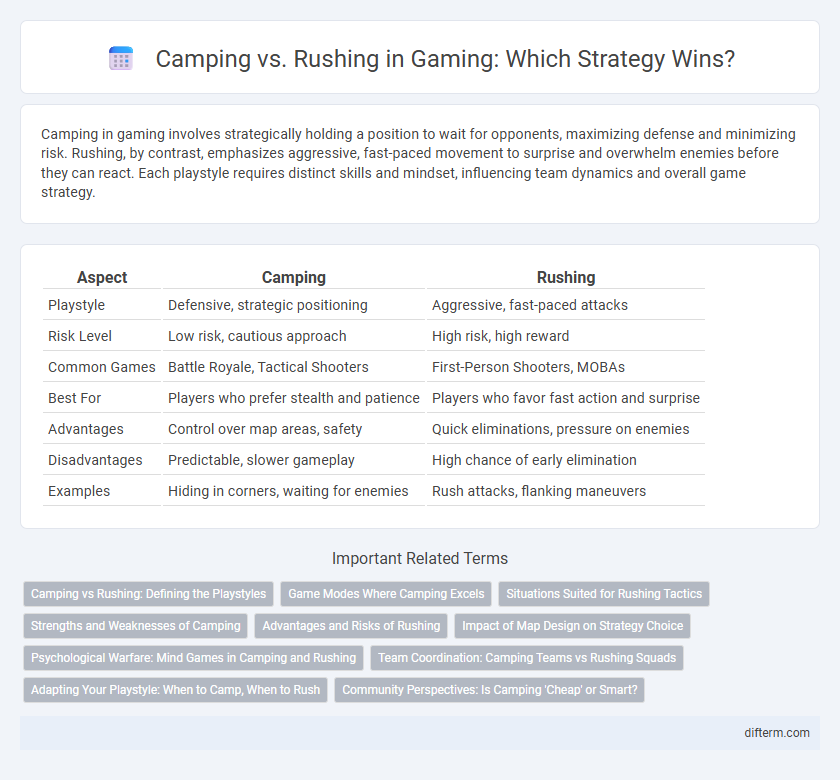Camping in gaming involves strategically holding a position to wait for opponents, maximizing defense and minimizing risk. Rushing, by contrast, emphasizes aggressive, fast-paced movement to surprise and overwhelm enemies before they can react. Each playstyle requires distinct skills and mindset, influencing team dynamics and overall game strategy.
Table of Comparison
| Aspect | Camping | Rushing |
|---|---|---|
| Playstyle | Defensive, strategic positioning | Aggressive, fast-paced attacks |
| Risk Level | Low risk, cautious approach | High risk, high reward |
| Common Games | Battle Royale, Tactical Shooters | First-Person Shooters, MOBAs |
| Best For | Players who prefer stealth and patience | Players who favor fast action and surprise |
| Advantages | Control over map areas, safety | Quick eliminations, pressure on enemies |
| Disadvantages | Predictable, slower gameplay | High chance of early elimination |
| Examples | Hiding in corners, waiting for enemies | Rush attacks, flanking maneuvers |
Camping vs Rushing: Defining the Playstyles
Camping emphasizes strategic defense by maintaining a fixed position to control key areas and gather information, often leading to prolonged engagements and careful resource management. Rushing prioritizes aggressive movement and quick elimination of opponents through high-speed assaults and surprise attacks, aiming to destabilize enemy plans and seize early advantages. Both playstyles require distinct skill sets and situational awareness, influencing overall team dynamics and match outcomes in competitive gaming.
Game Modes Where Camping Excels
Camping excels in game modes with objectives that require area control, such as search and destroy or domination, where holding strategic positions provides a tactical advantage. Defensive playstyles in such modes benefit from patience and map awareness, allowing players to secure key chokepoints and ambush opponents. This approach often yields higher survival rates and consistent objective control compared to aggressive rushing tactics.
Situations Suited for Rushing Tactics
Rushing tactics excel in close-quarters maps and fast-paced game modes where quick eliminations and aggressive map control provide a strategic advantage. Players benefit from rushing in early rounds to disrupt enemy setups and gain valuable intelligence on opponent positions. High mobility classes and weapons suited for short to medium range engagements further enhance the effectiveness of rushing strategies.
Strengths and Weaknesses of Camping
Camping in gaming offers strategic advantages such as increased map control, enhanced defense, and the ability to ambush opponents by maintaining a stationary position. However, its weaknesses include reduced mobility, predictability, and vulnerability to being flanked or outnumbered by more aggressive rushing players. Effective camp strategies require patience, map knowledge, and coordination to offset these limitations.
Advantages and Risks of Rushing
Rushing in gaming offers the advantage of quickly overwhelming opponents and securing early objectives, leveraging speed and surprise for tactical dominance. However, rushing carries significant risks such as exposure to ambushes and limited resource management, often leading to higher chances of player elimination. Mastering rush strategies requires balancing aggression with situational awareness to capitalize on momentum while minimizing vulnerabilities.
Impact of Map Design on Strategy Choice
Map design significantly influences the choice between camping and rushing strategies in gaming by shaping player movement and engagement points. Tight corridors and numerous hiding spots favor camping, allowing players to exploit ambush opportunities and control key choke points. Conversely, open layouts with multiple access routes encourage rushing by enabling faster rotations and dynamic encounters.
Psychological Warfare: Mind Games in Camping and Rushing
Camping in gaming leverages psychological warfare by creating tension and inducing frustration in opponents, forcing them to second-guess their strategies and become impatient. Rushing applies pressure with rapid movements and aggressive tactics that overwhelm enemies, disrupting their focus and causing panic. Mastering these mind games enhances a player's control over the battlefield by exploiting enemy psychological vulnerabilities.
Team Coordination: Camping Teams vs Rushing Squads
Camping teams emphasize strategic positioning and communication, leveraging map control to anticipate enemy movements and secure objectives with minimal risk. Rushing squads prioritize speed and aggression, relying on synchronized attacks and rapid decision-making to overwhelm opponents before they can react. Effective team coordination for both playstyles requires clear roles, real-time information sharing, and adaptive tactics to exploit enemy weaknesses and maximize combat efficiency.
Adapting Your Playstyle: When to Camp, When to Rush
Adapting your playstyle in gaming requires recognizing situations where camping offers tactical advantages, such as holding strategic positions or conserving resources. Rushing becomes optimal during moments of surprise or when controlling momentum against opponents in fast-paced games like Battle Royale or FPS titles. Mastering the balance between camping and rushing enhances overall game strategy, improving chances of victory.
Community Perspectives: Is Camping 'Cheap' or Smart?
Camping in gaming often sparks debate within the community, with some labeling it as "cheap" due to its perceived lack of skill and promoting passive playstyles. Others argue camping is a smart tactic, leveraging map knowledge and strategic positioning to outwit opponents and survive longer. The division highlights diverse play preferences, with competitive players valuing adaptability while casual gamers may prefer aggressive rushing for fast-paced action.
camping vs rushing Infographic

 difterm.com
difterm.com